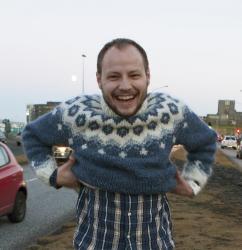
If you’ve been following my Milkywhale-watching tour (or stalking, whatever), you’d know I’ve been part of the dance parties they’ve started in a café and clothing shop. As I record my sightings of the this new whale species, I learn a little more about it. These are my newest findings.
One thing you may not have known (because I didn’t quite understand it myself, let alone clarify it) is this: Milkywhale is a collaborative project between the choreographer-performer Melkorka and musician-producer Árni Rúnar, essentially a band. So at times, the plural pronoun “they” is appropriate. But Milkywhale is also the name of the persona assumed by the front-woman, almost like a character. So at other times, the singular pronoun “she” is also appropriate. So now you know. “They” are a pair of pop geniuses who have created “her,” and I’ll use the terms thusly.
Now that the pedantry is over, you’ll also remember how excited I was to see what they could bring to their official show, assuming there’d be nearly unlimited potential. That is indeed one of the most palpable aspects of Melkorka’s performances: this feeling of the infinite. There seems to be this infinite energy, infinite fun, and certainly infinite dancing.
Which is why I was slightly bummed to discover at the only official show that despite the amount of talent and preparation of the artists, there were still limits. At their Tjarnarbíó performance in August, the audience was seated above her (auditorium-style), so we were able to see the stage floor. Having performed with minimal lighting throughout most of the performance, there was an unprecedented explosion of visual effects in the finale. The lights projected onto the floor made it appear as though beams of pure pop energy were blasting from her body. These same visuals were used on the vertical screen behind her in Norðurljós at Harpa. While the effects themselves were still dazzling, they lost a little magic in their vertical format. That said, with the screen behind her, she made good use of the newfound power of the silhouette.
The only other constraint was time. Their time-slot was a scant 30 minutes, which only allowed them to play the same set they’ve had for their off-venue shows. While this may be good news to the off-venue goers to not have missed as much, I was hoping they’d finally have the opportunity to show off some of their other material. There was so much artistry, so much hilarity, and so much weirdness from their August performance that still has yet to grace the eyeballs and earholes of Airwaves-goers.
What is the most important, however, is that the Airwaves-goers didn’t seem to mind one bit. In fact, they ate it up. They wolfed it down like they were starved for dancing. I’ve seen long-time Airwaves favorites with half-empty venues as early as 9:40 and who turns up often watches with arms crossed and steely reserve. This was not the case for newcomer Milkywhale. The hall was full, peopling were dancing, laughing, screaming along, and generally losing their shit.
All this just goes to show that you don’t necessarily need state-of-the-art, meticulously timed special effects or even an hour of time to build up a proper dance party. All you need is one ludicrously talented musician and one equally talented performer. If you have these, the audience will come. And they will dance. But seriously, someone, please give these two a two hour set, every strobe-light in this country, and Vodafone Hall. Thanks!
Buy subscriptions, t-shirts and more from our shop right here!















